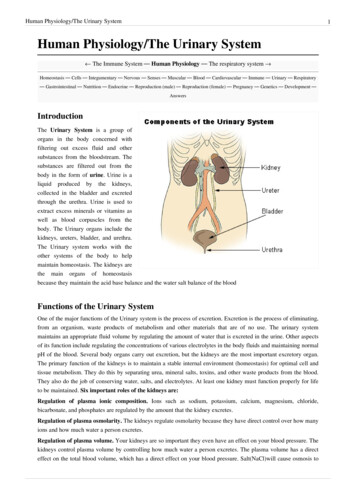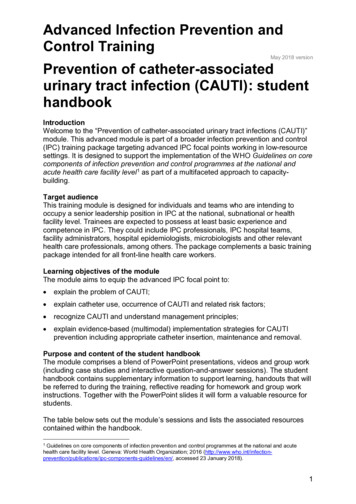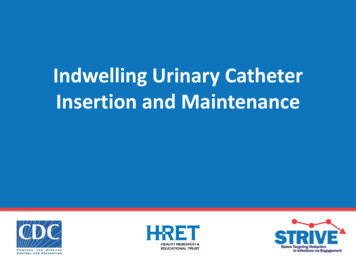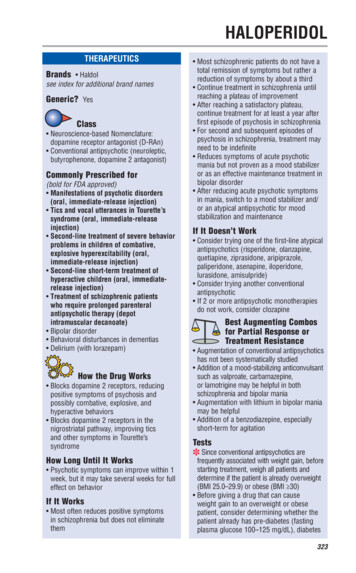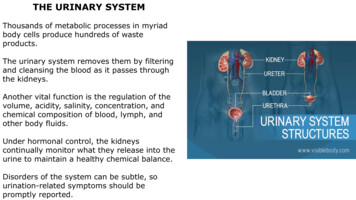
Transcription
THE URINARY SYSTEMThousands of metabolic processes in myriadbody cells produce hundreds of wasteproducts.The urinary system removes them by filteringand cleansing the blood as it passes throughthe kidneys.Another vital function is the regulation of thevolume, acidity, salinity, concentration, andchemical composition of blood, lymph, andother body fluids.Under hormonal control, the kidneyscontinually monitor what they release into theurine to maintain a healthy chemical balance.Disorders of the system can be subtle, sourination-related symptoms should bepromptly reported.
The urinary system is composed of a pair ofkidneys, a pair of ureters, a bladder, and aurethra.These components together carry out theurinary system’s function of regulating thevolume and composition of body fluids,removing waste products from the blood, andexpelling the waste and excess water from thebody in the form of urine.The two kidneys are reddish organs resemblingbeans in shape that are situated on either sideof the abdomen just above the waist andtowards the back of the body.The kidneys contain microscopic filtering unitsthat remove waste, unwanted minerals, andexcess water from the blood as urine.Each kidney is connected to the bladder by along tube called a ureter, which transports urineaway.
The bladder is a hollow, muscular organsituated centrally in the pelvis; it storesurine until it is convenient to release it.At a certain volume, stretch receptors in itswall transmit nervous impulses that initiatea conscious desire to urinate. The urethrathen conducts urine from the bladder to theoutside.
THE KIDNEYSThe kidneys sit at the back of theabdominal wall and at the startof the urinary system.These organs are constantly atwork: Nephrons, tiny structures inthe renal pyramids, filtergallons of blood each day. The kidneys reabsorb vitalsubstances, remove unwantedones, and return the filteredblood back to the body. As if they weren’t busyenough, the kidneys alsocreate urine to remove all thewaste.
Kidney cross sectionThis cutaway shows the kidney’smain layers, the cortex and themedulla, which form segmentsknown as renal pyramids.The renal artery and vein circulatehuge amounts of blood – about 21/2 pints/min at rest, which is upto one-quarter of the heart’s totaloutput.
The kidneys are located behindthe peritoneum, and so arecalled retroperitoneal organs.They sit in the back of theabdomen between the levels ofthe T12 and L03 vertebrae.The right kidney is slightlylower than the left kidneyto accommodate the liver.Both kidneys are beanshaped and about the sizeof an adult fist.
Blood enters the kidneys through renalarteries.These arteries branch into tinycapillaries that interact with urinarystructures inside the kidneys (namelythe nephrons).Here the blood is filtered.Waste is removed and vital substancesare reabsorbed back into thebloodstream.The filtered blood leaves through therenal veins.All the blood in the body moves inand out of the kidneys hundredsof times each day—that’s about200 quarts of liquid to be filteredevery 24 hours.
Each kidney contains over 1million tiny structures callednephrons.The nephrons are located partlyin the cortex and partly insidethe renal pyramids, where thenephron tubules make up mostof the pyramid mass.Nephrons perform theprimary function of thekidneys: regulating theconcentration of water andother substances in thebody.They filter the blood, reabsorbwhat the body needs, andexcrete the rest as urine.
The kidneys filter unwantedsubstances from the blood andproduce urine to excrete them.There are 3 main steps of urineformation:Glomerular filtration,ReabsorptionSecretion.These processes ensure thatonly waste and excess water areremoved from the body.
Each nephron has a glomerulus,the site of blood filtration.The glomerulus is a network ofcapillaries surrounded by acuplike structure, the glomerularcapsule (or Bowman’s capsule).As blood flows through theglomerulus, blood pressurepushes water and solutes fromthe capillaries into the capsulethrough a filtration membrane.This glomerular filtration beginsthe urine formation process.
The nephrons of the kidneysprocess blood and create urinethrough a process of filtration,reabsorption, and secretion.Urine is about 95% waterand 5% waste products.Nitrogenous wastes excreted inurine include urea, creatinine,ammonia, and uric acid.Ions such as sodium, potassium,hydrogen, and calcium are alsoexcreted.
Urine produced in the kidneystravels down the ureters intothe urinary bladder.The bladder expands like anelastic sac to hold more urine.As it reaches capacity, theprocess of micturition, orurination, begins.Involuntary musclemovements send signals tothe nervous system, puttingthe decision to urinate underconscious control.
The internal urethral sphincter andthe external urethral sphincter bothprovide muscle control for the flowof urine.The internal sphincter isinvoluntary.It surrounds the opening of thebladder to the urethra and relaxesto allow urine to pass.The external sphincter isvoluntary.It surrounds the urethra outsidethe bladder and must be relaxedfor urination to occur.
Smooth muscle stretch initiates themicturition reflex by activatingstretch receptors in the bladderwall.This autonomic reflex causes thedetrusor muscle to contract and theinternal urethral sphincter muscleto relax, allowing urine to flow intothe urethra.The stretch receptors also senda message to the thalamus andthe cerebral cortex, givingvoluntary control over theexternal urethral sphincter.We usually gain this control ofurination between the ages of 2and 3, as our brains develop.
3D PRINTING AND OTHER NEW TECHNOLOGIESTO HELP PATIENTSIn a first for the Middle East, UAE doctors have used 3D printingtechnology to help safely remove a cancerous tumor from a 42year-old woman’s kidney.A team of doctors in Dubai have successfully removed a kidneytumor with the help of a transparent, patient-specific 3D printedsurgical aid. Not only did the 3D printed aid help them to carefullyplan their surgical process for removing the tumor from the patient,but it allowed them to shave an hour off the total operation time.The 3D print was created based off of the patient’s CT scans andultrasounds, and was 3D printed from transparent and coloredplastics so that the doctors could visualize where the tumor waslocated. Since the technology has not yet been integrated in UAEhospitals, the 3D print was ordered from the U.S.Upon receiving the 3D printed kidney model, the team of doctors,led by Dr Yaser Al Saeedi, was able to properly map out its surgicalprocess to make the actual procedure as minimally invasive aspossible. Finally, when it came time to operate, the surgeons wereready and the procedure went very well.
Of the potential 3D printed organs fortransplant, a 3D printed kidney is one ofthe most difficult. That’s because of thecomplexity of the organ’s structure,which is necessary for its function.In 2016, Jennifer Lewis’ lab at Harvarddeveloped a novel printing method thatuses ‘inks’ consisting of kidney cells andsurrounding material. This ink ends hasthe consistency of toothpaste and can beextruded at room temperature, allowingthem to make complex tissue structures.Thanks to this novel ink, the researchgroup has been able to recreate part ofthe nephron, the functional unit of thekidney. The nephron is responsible forfiltering the blood and reabsorbing all ofthe useful components and excreting outthe rest. With this achievement, the fieldof 3D printed organs for transplant is alot closer now to creating a functionalkidney.
After more than a decade, a 3D bio-printed bladder,created by Dr. Anthony Atala at Boston Children’sHospital, is sustaining the live of a patient.The 3D bioprinted organ was made to replace patientLuke Massella’s defective bladder in 2004. Sincethen, Massella has not required any further surgery.The bladder was made using a sample of Massella’bladder tissue, and modified inkjet printer,presumably used to build a sort of scaffold/host forthe cells.Incubated in lab condition, the new bladder wasgrown in 2 months, and then successfullytransplanted into the patient.Massella is 1 of 10 people with a bioprintedbladder grown from his own cells.According to Dr. Atala, flat structures like skin areeasiest to print, whereas tubular structures like bloodvessels and hollow non-tubular organs like bladdersare more complex.
body cells produce hundreds of waste products. The urinary system removes them by filtering and cleansing the blood as it passes through the kidneys. Another vital function is the regulation of the volume, acidity, salinity, concentration, and chemical composition of blood, lymph, and other


